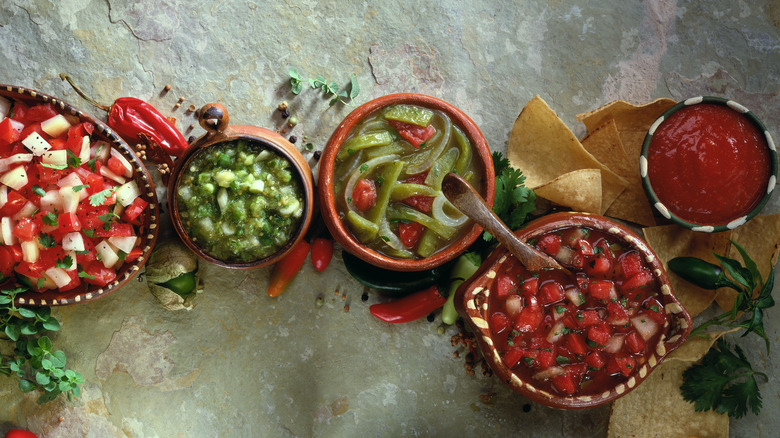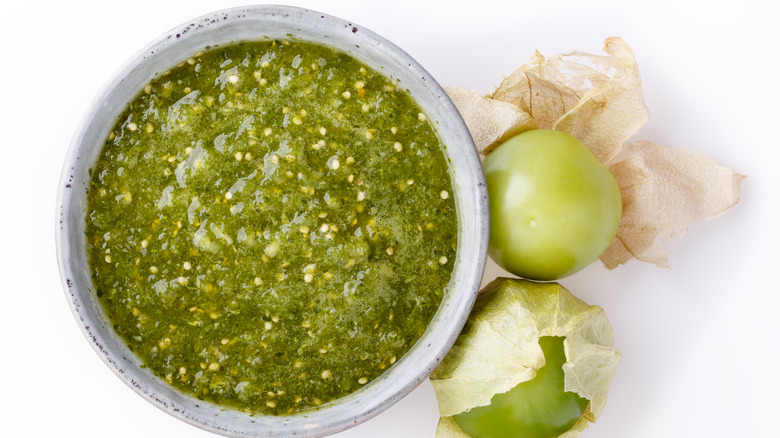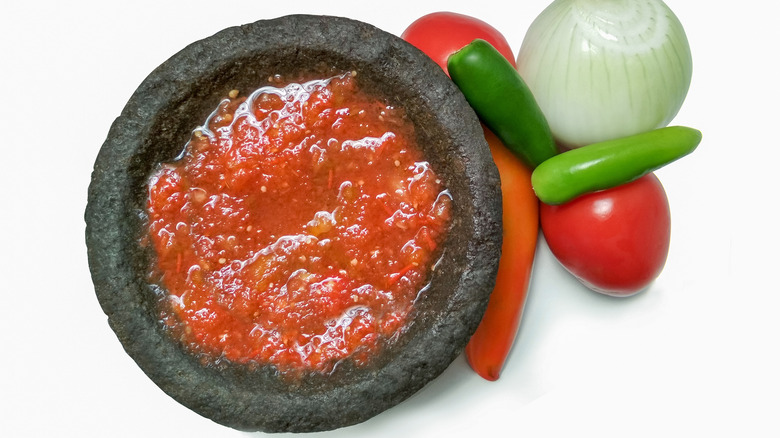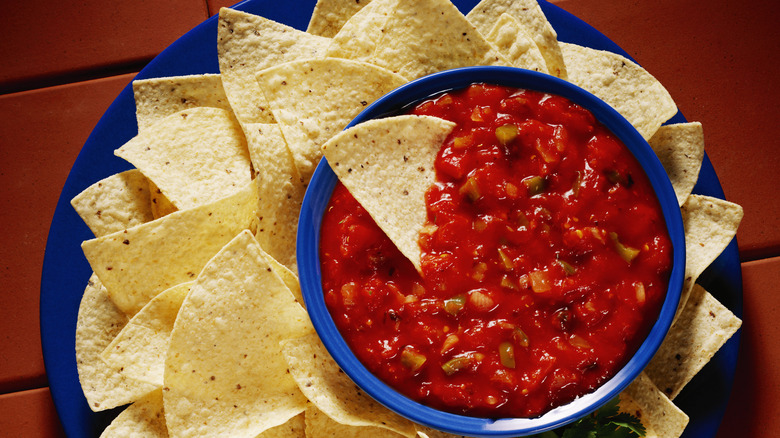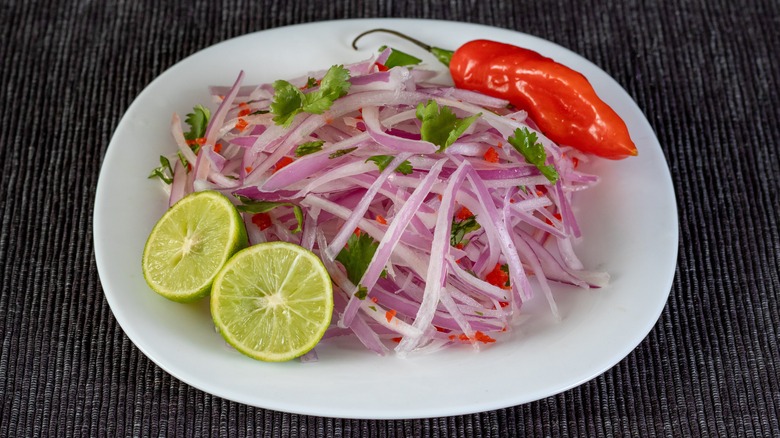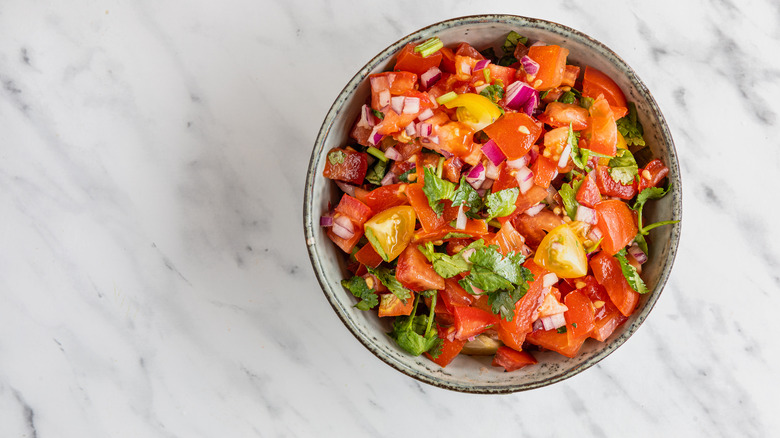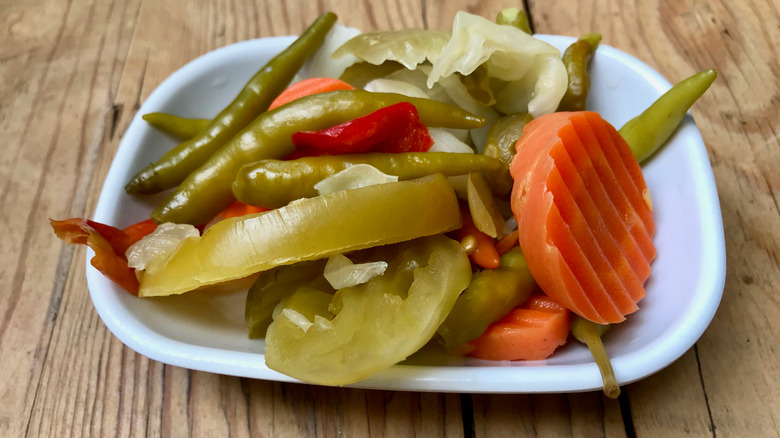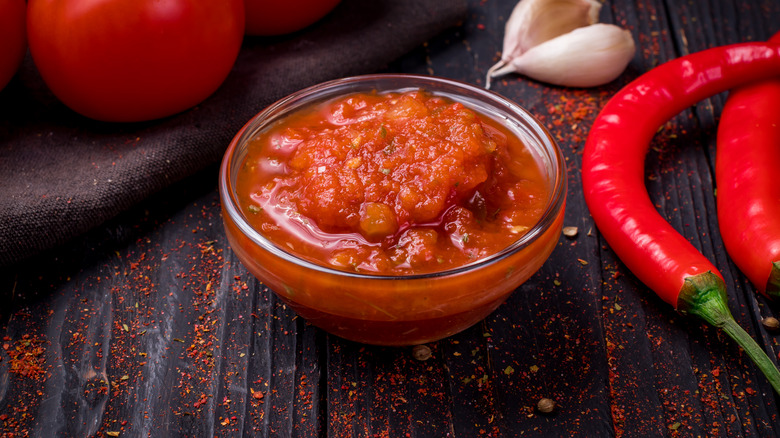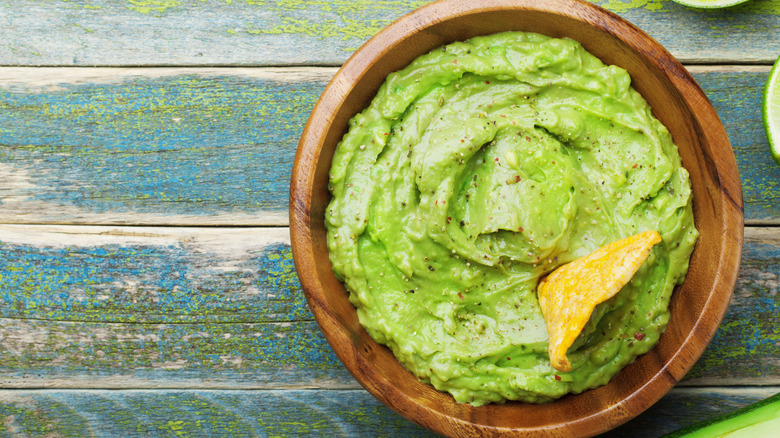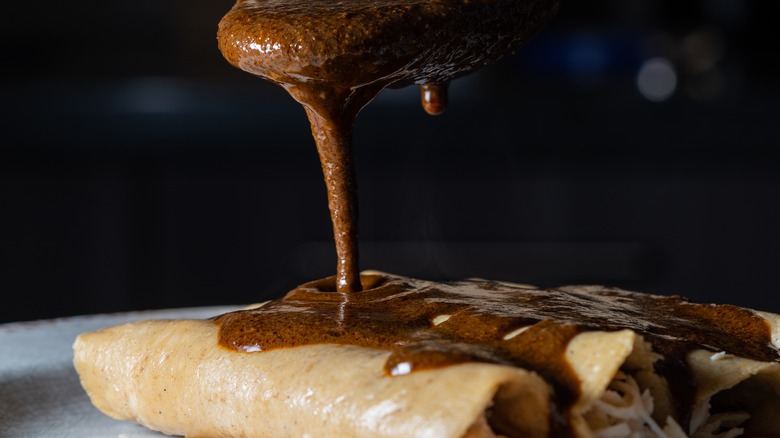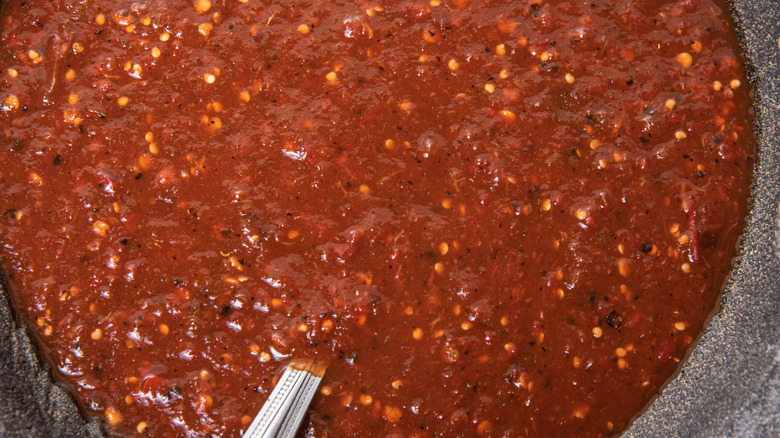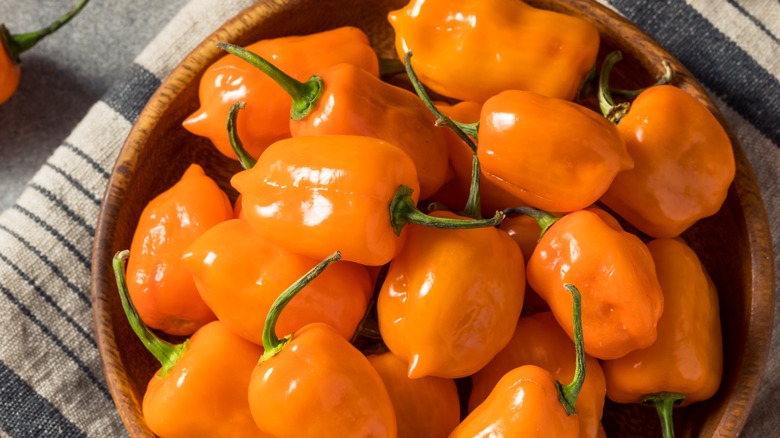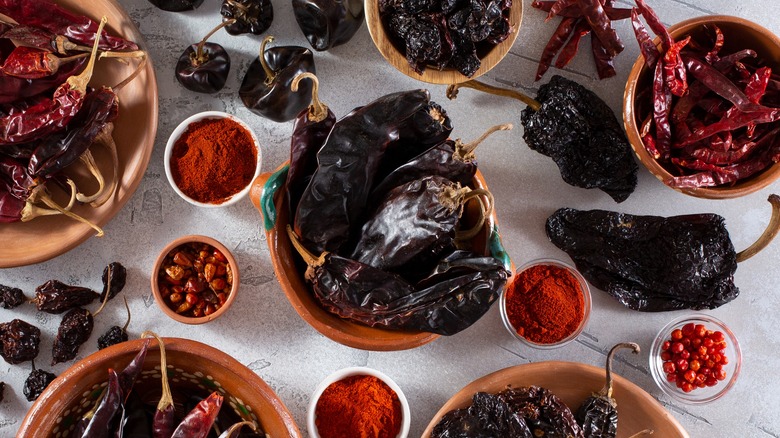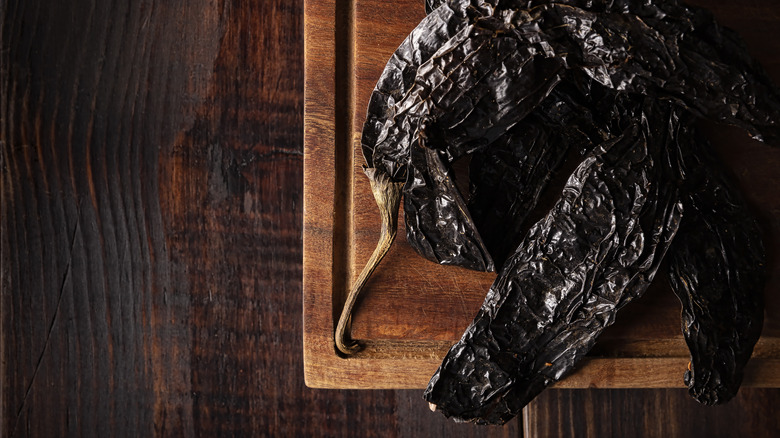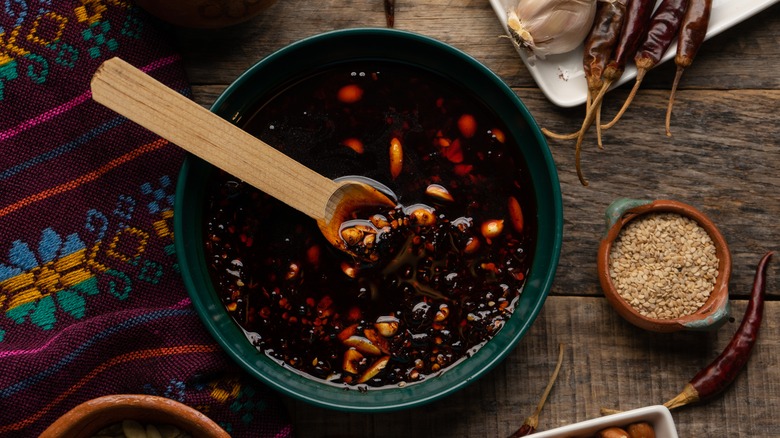14 Types Of Salsa, Explained
We may receive a commission on purchases made from links.
Salsa is considered by many to be the cornerstone of Mexican cuisine. The use of it in Mexico predates Spanish colonialism, and even the word salsa was used then, too (salsa is Spanish for sauce). Salsa's role in both Mexican and Mexican-American cooking has changed over time, but the core elements have remained the same.
According to Gabriela Cámara, author of My Mexico City Kitchen, "There are so many Mexican salsas that you could easily fill a cookbook with nothing else. A salsa can be cooked or raw, blended or chunky, made with fresh chiles or with dried ones that you soak and blend." Even though the number of Mexican salsas is virtually endless, most recipes fall into several main categories or types. We've rounded up some of the most commonly found salsas to take a look at what makes them unique, and how to use them in your cooking.
Salsa verde
Not to be confused with salsa verte, salsa verde is a green, tomatillo-based salsa. Traditional recipes typically call for roasting or simmering tomatillos, serrano or jalapeño chiles, onion, and garlic until softened, then blending it all with fresh cilantro. It's an extremely versatile salsa that serves as the base for so many more recipes, like chilaquiles or enchiladas.
Variations of the base recipe include adding avocado, which creates a creamy salsa verde. This kind of salsa verde is sometimes referred to as salsa verde cruda, and the ingredients are meant to be kept raw and never heated. The raw version of salsa verde works very well on tacos or even on a plate of eggs. According to Cámara, the smallest tomatillos are the least bitter and best for salsa verde, and the purple variety, even though less traditional, are less acidic and also work well in these recipes.
Salsa taquera
Salsa taquera is one of the most common forms of salsa and a type that lots of people think of when they think of salsa. Translating to "taco shop sauce," salsa taquera invariably begins with a fresh tomato base. Chiles, traditionally chiles de árbol, get blended with tomatoes, onion, garlic, and salt. While the exact preparation can differ between recipes, it is common to see the ingredients charred or boiled before being blended. It's not uncommon to see fresh lime or chopped cilantro added to this type of salsa, too.
Some recipes for this fire-roasted salsa use a pinch of sugar or a drop of honey to temper the heat and acidity. It might sound weird, but this ingredient will change your salsa forever. Whichever way you make it, this style of salsa works equally well drizzled over tacos as it does as a dip for tortilla chips.
Salsa roja
Salsa roja, or red salsa, is very similar to salsa taquera but uses only fresh chiles. Salsa roja asada (charred red salsa) or salsa Mexicana (a cooked version) are common variations of this type of salsa. This type is often the kind you might find served with chips at a typical Mexican food restaurant in America. The flavor is acidic, fresh, and slightly spicy, though not usually so spicy that it can't be eaten on a tortilla chip. Other uses include topping a taco or even stirring into canned black beans to increase the flavor.
This type of salsa is also the kind found in most types of jarred salsa on grocery store shelves in America. All the ingredients that go into this salsa start fresh, and the best versions use peak-season tomatoes. Jarred or canned tomatoes can also work in a pinch, and many salsas rojas eaten across the country are made this way.
Salsa criolla
Sometimes referred to as salsa brava (or "fierce" salsa), salsa criolla is a spicy condiment made of raw Julienned and marinated red onion and habanero chiles, (via My Mexico City Kitchen). While not exactly a sauce, salsa criolla serves as a topping for all kinds of dishes. The marinade is often a tart combination of lime juice, olive oil, and salt. In certain recipes, the chiles can be substituted for other hot varieties, like aji amarillo.
Salsa criolla is a staple in Peruvian cuisine, though you will see similar versions pop up all over Central and South America. This condiment tastes amazing on tacos but is also very well suited to eating with asados, or barbecued meat. When making salsa criolla, the lime juice needs time to marinate the onions (just like a ceviche) so the best practice is to make the salsa at least 30 minutes before consuming it.
Salsa fresca
While many salsas are uncooked salsas, only one type of fresh salsa is called salsa fresca, or pico de gallo. Pico de gallo (which translates to "rooster's beak"), is a fresh, chunky, chopped salsa made with tomatoes, onions, jalapeños, cilantro, and lime. Other types of peppers can be used in place of the jalapeño, or even a blend of various peppers. Salsa fresca is a very versatile recipe and there are many variations. Other fresh ingredients can be substituted for the tomatoes (or used in addition to them), such as cucumber or pineapple.
Salsa fresca is best eaten fresh, and after the first day, the ingredients tend to break down from the acidity in the lime, so it's best to only make just as much as you plan to eat. It is as tasty spooned over tacos as it is eaten with tortilla chips and goes particularly well on beer-battered fish tacos.
Salsa bruja
More of a pickle than a sauce, salsa bruja (or "witch sauce") is a combination of chiles, onion, garlic, vinegar, olive oil, and vegetables, such as carrot or cactus paddles. It's considered a sauce because most people spoon some of the pickling liquid over their tacos (or other dishes) along with the vegetables. Salsa bruja is also sometimes called "verduras en escabeche," or hot pickled vegetables. The liquid can be made in many different ways and sometimes various spices are added, like peppercorns or allspice.
Salsa bruja is traditionally eaten with seafood cocktails or crab tostadas. It isn't uncommon to see a vat of this sauce next to the other salsas at your typical spot, as many people like to eat this on the side along with tacos, burritos, chilaquiles, and more. Salsa bruja lasts for a long time when stored appropriately and the flavor will continue to deepen with age.
Salsa ranchera
Salsa ranchera (which translates to country or ranch sauce) is a cooked red salsa that can be eaten plain with chips or used as an ingredient in another dish, like enchiladas (picture the red sauce on top of and usually in the enchiladas). Salsa ranchera is probably one of the best and most well-known varieties of boiled salsa and it is also a variant of salsa roja.
Cooking the sauce breaks down the vegetables to create a smooth, pureed salsa. The cooking aspect combined with the high level of acidity makes this salsa very easy to jar or can, and it can be a great way to preserve those fresh summer tomatoes you just do not know what to do with. Typically, salsa ranchera is made with seeded chiles and tomatoes for a better texture, and it is sometimes thinned with water if it is too thick, depending on your preference.
Salsa de aguacate
Salsa de aguacate, or avocado salsa, is very similar to guacamole, though there are key differences. Salsa de aguacate is similar to salsa verde but with avocado blended in or folded in. The use of avocado pre-dates the Spanish colonial era, and it was from the written historical records that we learned how the ancient Aztecs consumed the āhuacatl, as they referred to the avocado, (via Familia Kitchen).
Salsa de aguacate can be found served with chips or eaten on tacos or tlacoyos, an oval-shaped masa snack that gets topped with various ingredients. No matter which way it's eaten, salsa de aguacate does not have a long shelf life. Avocados begin to turn brown when exposed to air because of a chemical process known as oxidation. Acidic ingredients like lime can slow it down, but it is still best to eat this type of salsa right away.
Salsa de cacahuate
Salsa de cacahuate translates to peanut sauce and is a salsa that uses peanuts to add texture and richness. The fatty nuttiness of the peanuts tempers the spiciness of the chiles to create a very balanced and unique sauce that is endlessly versatile (unless you happen to be allergic to peanuts, in which case we're sorry).
Those most familiar with Mexican-American food might be thrown off by the addition of peanuts to salsa, but adding ground nuts to salsas and sauces is not at all uncommon in Mexican cuisine. Traditional mole sauce often has some kind of nuts or seeds ground in for body and flavor, and some shortcut mole sauces even call for almond or peanut butter. Trader Joe's recently began selling a salsa de cacahuate this year, which the brand says works as well as a dip as it does on breakfast, burritos, burgers, or a big plate of sizzling fajitas.
Salsa molcajete roja
A molcajete is a traditional Mexican mortar and pestle made from volcanic rock that is such an integral part of the cuisine that they are often passed down from generation to generation. The texture of the rock helps to grind down the ingredients that are put into it. Salsas molcajetes are chunky, hand-ground sauces made in the mortar and pestle, and traditionally even guacamole was made this way. Sometimes made as a salsa verde (but more commonly as a salsa roja), salsa molcajete is a very traditional recipe that typically starts with the ingredients being toasted in a comal, a type of seasoned griddle used in Mexican cuisine.
Salsa molcajete has a distinctively smoky flavor from the roasted ingredients, and can often be identified by black flecks from the fire-roasted ingredients. This salsa is often incredibly flavorful and works best in small quantities as a condiment for other dishes, like fatty carnitas or crispy taquitos.
Habanero amarilla salsa
One of the less common types of salsa is habanero amarilla salsa, a sauce made from super-hot yellow habanero peppers (if you're not used to spice, maybe pick another salsa). Some habanero salsas employ sweet ingredients to temper the intense heat of the habaneros, like this mango habanero hot sauce. Almost all salsas of this type are blended completely smooth and often eaten more as a hot sauce than what most Americans would think of as salsa.
Habanero peppers can range in color from bright yellow to deep orange, and some are red or green. For the best color, choose the ripe, sun-yellow habaneros, which often have a deeper flavor. Since this salsa can be extremely hot, the salsa should be treated with care and used in small quantities. Always wear gloves when handling habanero peppers, or be sure to wash your hands after touching them to avoid spreading the burning capsaicin to your eyes.
Salsa guajillo chile
In the world of salsas, some salsas contain dried chiles, and other salsas are created from a base of mostly dried chiles. In some cases, like that of salsa guajillo chile, one specific type of chile is the star of the show. Guajillo chiles are known for their moderate heat and deep, smoky flavor. Of all dried chiles in Mexican cuisine, the guajillo is the second most commonly used after ancho, (via Mexico News Daily). Guajillos also form the base of most mole recipes.
Creating a guajillo chile salsa is quite simple and begins with reconstituting the dried chiles with boiling hot water. The most simple recipes have a few tomatoes added for body, and maybe some raw garlic or chopped onion, says Mexico News Daily. The same ratio can be applied to steak or chicken marinades made with guajillo chile, but with some added lime juice for acidity.
Salsa de chile pasilla
Another salsa in the realm of dried chile salsas is salsa de chile pasilla. Pasilla chiles have a mild level of heat but are big on flavor, with an earthy sweetness that brings to mind dried fruit and chocolate. Considered one of the "Holy Trinity" of Mexican peppers, the pasilla shows up in all kinds of recipes from soups to salsas to sauces and marinades. When used in sauces (like for enchiladas), pasillas are usually used in smaller quantities, though always blended smooth.
Simple salsas can be made with pasilla chiles, including a tomatillo version with reconstituted pasillas, tomatillo, garlic, and salt. More elaborate salsas exist as well, sometimes adding onion, lime, and spices like cinnamon. Even when other ingredients, like tomatillo and tomato, accompany the pasilla chile, the chiles have such a strong flavor that the predominant taste that comes through on the palate is the pasilla.
Salsa macha
More of a chile oil than what many Americans would think of as a salsa, salsa macha is one of the most unique and identifiable salsas in the Mexican cooking lexicon. This sauce of Veracruzan origin has a few base ingredients, plus some others that can be substituted for similar items to switch up the flavor, (via Texas Monthly). Salsa macha almost invariably starts with dried chiles, ground nuts and seeds, and oil. Some recipes add other ingredients, like the dried cherries or cacao nibs in this version from Masienda.
Salsa macha can be made in a molcajete or in a blender. Once blended, the sauce will separate and solids sink to the bottom of the oil. Before consuming, it is best to mix it up to make sure a little bit of everything makes it into each spoonful. It's also possible to just spoon a little of the chile oil off the top for drizzling over soups, bread, or tortilla.
